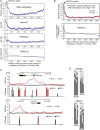Transient bursts of Zscan4 expression are accompanied by the rapid derepression of heterochromatin in mouse embryonic stem cells
- PMID: 26324425
- PMCID: PMC4596397
- DOI: 10.1093/dnares/dsv013
Transient bursts of Zscan4 expression are accompanied by the rapid derepression of heterochromatin in mouse embryonic stem cells
Abstract
Mouse embryonic stem cells (mESCs) have a remarkable capacity to maintain normal genome stability and karyotype in culture. We previously showed that infrequent bursts of Zscan4 expression (Z4 events) are important for the maintenance of telomere length and genome stability in mESCs. However, the molecular details of Z4 events remain unclear. Here we show that Z4 events involve unexpected transcriptional derepression in heterochromatin regions that usually remain silent. During a Z4 event, we see rapid derepression and rerepression of heterochromatin leading to a burst of transcription that coincides with transient histone hyperacetylation and DNA demethylation, clustering of pericentromeric heterochromatin around the nucleolus, and accumulation of activating and repressive chromatin remodelling complexes. This heterochromatin-based transcriptional activity suggests that mESCs may maintain their extraordinary genome stability at least in part by transiently resetting their heterochromatin.
Keywords: embryonic stem cells; heterochromatin; pericentromere.
Published by Oxford University Press on behalf of Kazusa DNA Research Institute 2015. This work is written by (a) US Government employee(s) and is in the public domain in the US.
Figures







Similar articles
-
Feeders facilitate telomere maintenance and chromosomal stability of embryonic stem cells.Nat Commun. 2018 Jul 5;9(1):2620. doi: 10.1038/s41467-018-05038-2. Nat Commun. 2018. PMID: 29976922 Free PMC article.
-
Zscan4 Inhibits Maintenance DNA Methylation to Facilitate Telomere Elongation in Mouse Embryonic Stem Cells.Cell Rep. 2017 Aug 22;20(8):1936-1949. doi: 10.1016/j.celrep.2017.07.070. Cell Rep. 2017. PMID: 28834755 Free PMC article.
-
MERVL/Zscan4 Network Activation Results in Transient Genome-wide DNA Demethylation of mESCs.Cell Rep. 2016 Sep 27;17(1):179-192. doi: 10.1016/j.celrep.2016.08.087. Cell Rep. 2016. PMID: 27681430 Free PMC article.
-
Zygotic Genome Activation Revisited: Looking Through the Expression and Function of Zscan4.Curr Top Dev Biol. 2016;120:103-24. doi: 10.1016/bs.ctdb.2016.04.004. Epub 2016 May 31. Curr Top Dev Biol. 2016. PMID: 27475850 Review.
-
Lsh, a guardian of heterochromatin at repeat elements.Biochem Cell Biol. 2005 Aug;83(4):548-54. doi: 10.1139/o05-119. Biochem Cell Biol. 2005. PMID: 16094458 Review.
Cited by
-
Transient ectopic expression of the histone demethylase JMJD3 accelerates the differentiation of human pluripotent stem cells.Development. 2016 Oct 15;143(20):3674-3685. doi: 10.1242/dev.139360. Development. 2016. PMID: 27802135 Free PMC article.
-
eIF4A2 targets developmental potency and histone H3.3 transcripts for translational control of stem cell pluripotency.Sci Adv. 2022 Apr;8(13):eabm0478. doi: 10.1126/sciadv.abm0478. Epub 2022 Mar 30. Sci Adv. 2022. PMID: 35353581 Free PMC article.
-
The chromosomal protein SMCHD1 regulates DNA methylation and the 2c-like state of embryonic stem cells by antagonizing TET proteins.Sci Adv. 2021 Jan 20;7(4):eabb9149. doi: 10.1126/sciadv.abb9149. Print 2021 Jan. Sci Adv. 2021. PMID: 33523915 Free PMC article.
-
Genes as Genome Stabilizers in Pluripotent Stem Cells.Adv Exp Med Biol. 2025;1483:21-47. doi: 10.1007/5584_2025_853. Adv Exp Med Biol. 2025. PMID: 40095244 Review.
-
Feeders facilitate telomere maintenance and chromosomal stability of embryonic stem cells.Nat Commun. 2018 Jul 5;9(1):2620. doi: 10.1038/s41467-018-05038-2. Nat Commun. 2018. PMID: 29976922 Free PMC article.
References
-
- Evans M.J., Kaufman M.H.. 1981, Establishment in culture of pluripotential cells from mouse embryos, Nature, 292, 154–6. - PubMed
-
- Bradley A., Evans M., Kaufman M.H., Robertson E.. 1984, Formation of germ-line chimaeras from embryo-derived teratocarcinoma cell lines, Nature, 309, 255–6. - PubMed
-
- Suda Y., Suzuki M., Ikawa Y., Aizawa S.. 1987, Mouse embryonic stem cells exhibit indefinite proliferative potential, J. Cell Physiol., 133, 197–201. - PubMed
Publication types
MeSH terms
Substances
Grants and funding
LinkOut - more resources
Full Text Sources
Other Literature Sources
Molecular Biology Databases

